Sometimes, you don’t want to overwhelm your opponent with numbers, or with technological superiority, or with clever tactics and skillful deployment. Sometimes, like Rocky Balboa, you just want to show the other guy that no matter how much he’s got, it’s not enough to take you down. And sometimes, you want to show him that in a way that is as disgusting as humanly possible – maybe even a little more.
When it comes to Kill Team, Death Guard bring a combination of solid weaponry and an utter refusal to care about the number of limbs you’ve shot off of them, letting them slog through oppressive amounts of oncoming fire and dish it back out just as readily. They’re potentially the toughest faction in the game save for possibly Custodes, and pack a hell of a wallop to go with their steadfast refusal to die. They can operate either as a small team of elite, impossible-to-kill warriors, or supplement their numbers with shambling Poxwalkers, a number of tough but mindless zombies who can shamble across the board. If you want to give your opponents a glimpse of the slow, inexorable march of death as it comes to claim all they hold dear, the Death Guard may be for you.
Table of Contents
Faction Overview
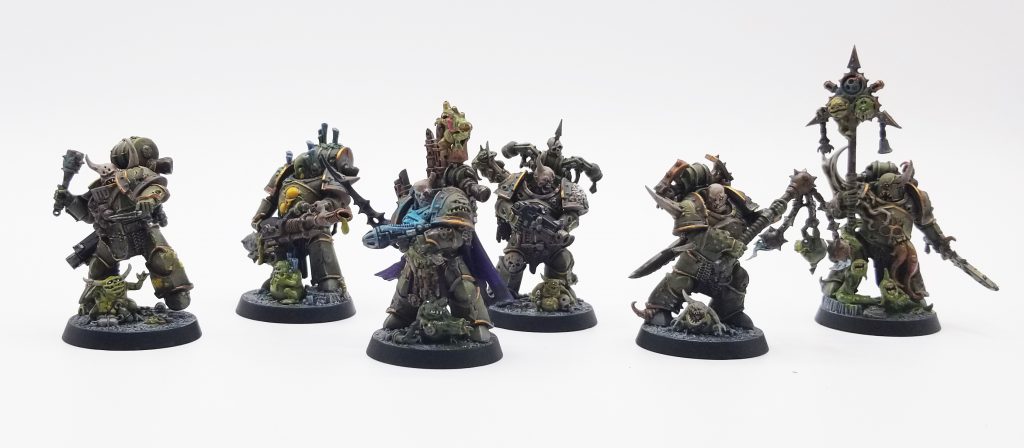
Strengths
- Disgustingly Resilient – Every Death Guard operative has this ability, which allows them to ignore lost wounds on a D6 roll of 5+ and prevents them from ever being injured. This means that every Death Guard operative functionally has 50% more wounds than it first appears, since on average they’ll require 50% more damage to bring down. Combine this with power armor giving them a 3+ save and you have a faction that’s more durable than any in the game save Custodes. They can further boost this with an icon, re-rolling 1s and 2s on their Disgustingly Resilient rolls.
- Move and Shoot – Death Guard don’t have a ton of heavy weapon options but their Inexorable ability from 40k is modeled in Kill Team 2.0 as none of their heavy weapons actually having the Heavy designation – they can move full speed and still shoot their Blight Launchers. That’s helpful, given you’ll need all the movement you can get.
- Melee Prowess – Plague Marines get a little extra “oomph” over their less bloated marine counterparts in the form of Plague Knives, which have a critical damage characteristic of 5 instead of 4, and you can boost their damage by 1 using the Mephitic Toxin Equipment. This makes them surprisingly lethal melee combatants in base form, and on top of that they have some very nasty melee weapon options on their Fighter and Champion operatives that give them some of the deadliest melee fighters in Kill Team.
- Elite/Horde Duality – Death Guard can choose to operate as either a 5-model Plague Marine kill team or an 11-model mixed team running 3 plague marines and 8 poxwalkers, letting them opt to play as either an elite team or a horde.
Weaknesses
- Slow – Death Guard are considerably slower than normal marines, packing a Movement of only 2⬤ for Plague Marines and Poxwalkers alike. This means that you’ll often have to use your third APL on a dash move to cover the same distance other marine can cover without breaking a sweat. Your charge distances are also shorter. Even in horde mode, your slower speed means that many other factions can easily out-maneuver you.
- Mindless – Poxwalkers are much more durable than your average chaff, but they pay for it by also being Mindless, meaning they have to pay 2 AP to pick up an objective or perform a mission action. This functionally means they can’t move to an objective and perform the action in the same turning point, and puts you at a decided disadvantage when it comes to early scoring.
- Ranged Firepower – Plasma guns and Blight launchers are fine, but Death Guard lack the kind of really heavy shooting that a missile launcher can provide. Still, this is a minor downside.
As can be expected by their fearsome reputation, the Death Guard are incredibly durable and dangerous operatives in Kill Team 2.0. Similar to other elite factions, these formidable foetid foes will often be outmanned, but they have the capacity for a large number of actions and some surprising firepower that makes them capable of gunning down swathes of enemy operatives.
How Do Death Guard Play?
Similar to how Death Guard play in Warhammer 40,000, your operatives are going to be extremely durable but ponderously slow. As the Kill Team board is a relatively small playing area your operatives are still going to be able to get around reasonably well, but you’re going to feel the cost of movement penalties like traversing terrain much more than factions with a higher M rate, and you’ll feel the effects pretty significantly when you have to use a dash action to reach an objective that other operatives might just walk to in a Normal Move action. Similar to their loyalist “brothers,” Plague Marines have a high APL stat (3), so while slow, individual operatives can be very dangerous and flexible.
Disgustingly Resilient is back and in Kill Team 2.0 it has reverted to its “classic” version that allows you to ignore wounds on a D6 roll of 5+, which suits the style of the game and scales well with the increase in wounds per operative. This means that each Death Guard model effectively has 50% more wounds, giving them 16 wounds, which can jump to ~22 wounds with a little support (the icon, which we’ll discuss later). While you’re still going to want to plan out your movements carefully and take advantage of cover, the faction is a bit more forgiving when it comes to making mistakes because occasionally your exposed operative is just going to smugly shrug off damage that would cripple a “normal” target. On that note, you also can’t be injured and don’t have to worry about those penalties.
While it is possible to make good use of concealment and cover as the game progresses, all Death Guard weapons are pretty vicious and with few exceptions operatives can reliably trade fire with enemies. Each special weapon choice offers up a good punch but with a near-constant use of Malicious Volleys and a cheap Virulent Rounds upgrade to operatives even the humble boltguns can become brutally effective. As they are often outnumbered in the field your operatives may get the chance to perform Overwatch actions frequently, so as you move your models about it can be helpful to draw a bead on more than one target in the event they get to fire again.
When it comes time to outfit your roster, the equipment section is really useful only if you are fielding traditional weapons (boltguns and plague knife/knives), otherwise you’re mostly just offered some expensive and situationally useful items. Provided you cluster your operatives loosely together–which can be a viable tactic anyway thanks to the Icon Bearer–the Plague Bell may be the most of the bunch. A Krak or Blight grenade might be useful on a Fighter to soften up a target before charging/attacking, but it is costly for a single-use item. The good news is that all of your operatives come with knives and several will still have Boltguns.
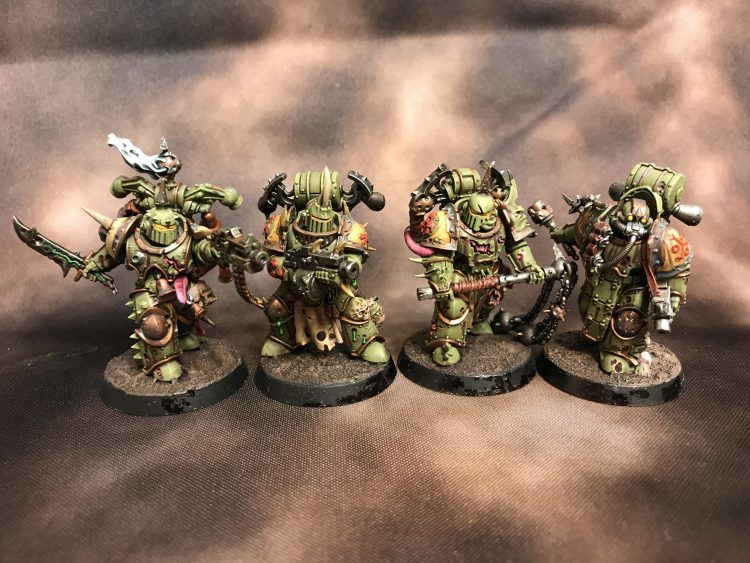
Death Guard Kill Teams
Death Guard kill teams are composed of two fire teams:
- Plague Marines
- Poxwalkers (max 1)
Plague Marine kill teams come with two operatives, but if you haven’t taken a leader yet you get to add a third Leader operative for free. This is basically the mechanism by which you can take kill teams consisting of five plague marines. Poxwalker fire teams come with 8 poxwalkers, each of which has a Group Activation of 2. Because they’re max 1, this means that your kill team will either consist of five plague marines or three plague marines and 8 poxwalkers.
Plague Marine kill teams can be made of Warriors (basic operatives), and can include one Gunner, Heavy Gunner, or Fighter and up to one Icon bearer. You can only include a non-warrior operative once. Your leader option is a Plague Marine Champion who can have your choice of bolt pistol, boltgun, or plasma pistol and plague knife, plague sword, or power fist.
Operatives

Plague Marine (Warrior)
Your bread and butter operative, simply kitted with a boltgun and plague knife. Even with a default loadout, you can be confident to play these operatives aggressively if needed. Virulent Rounds is a solid upgrade here and Mephitic Toxin makes them nasty melee fighters. Your team is almost always going to end up having one of these and while they’ll be the least flashy operative on your team, they’re pretty good all-rounders.

Plague Marine (Gunner)
Gunners don’t give up any of their melee deadliness and come with the option for three special weapons: A meltagun, a plasma gun, or the flamer-like plague belcher. The weapon selections here are standard stuff, but all of it is very powerful. While they’re going to be dangerous (and a target) wherever they go, having a gunner equipped with a meltagun to act as guardian for Hold the Line or a plasma gun for some fiery Execution/Deadly Marksman action is probably the best pick. The torrent effect on the belcher is interesting but Death Guard either want something with lots of range or the stopping power of a melta shot.
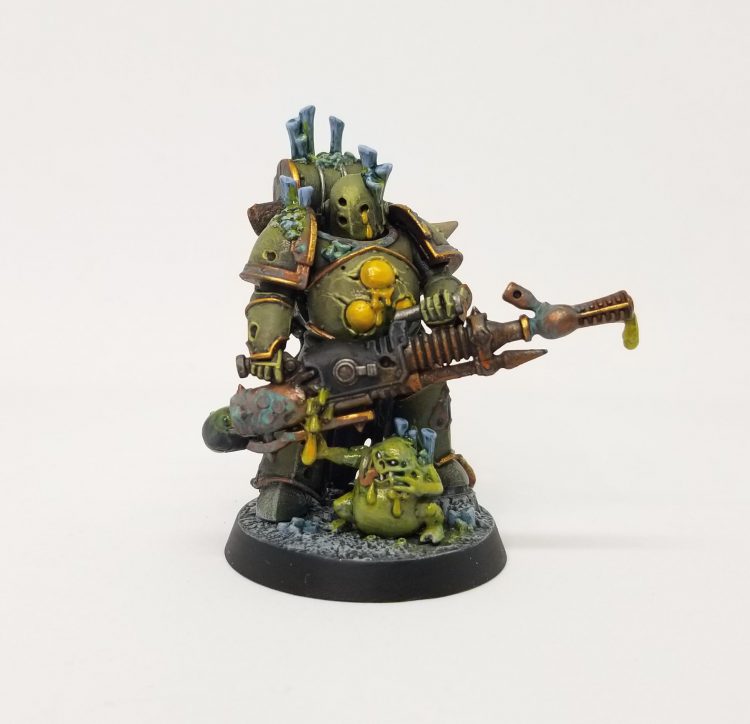
Plague Marine (Heavy Gunner)
You only get two choices here, but both are pretty potent. Overall the Blight Launcher is likely the better choice, as infinite range goes a long way and it’s one of the few sources of AP1 the faction has access to for harder targets. Four shots at 4/6 damage with AP1 is pretty solid, especially on a gun that still lets you normal move. Similar to the meltagunner comment above, though, a plague spewer guarding your drop zone is going to give most enemy operatives pause.
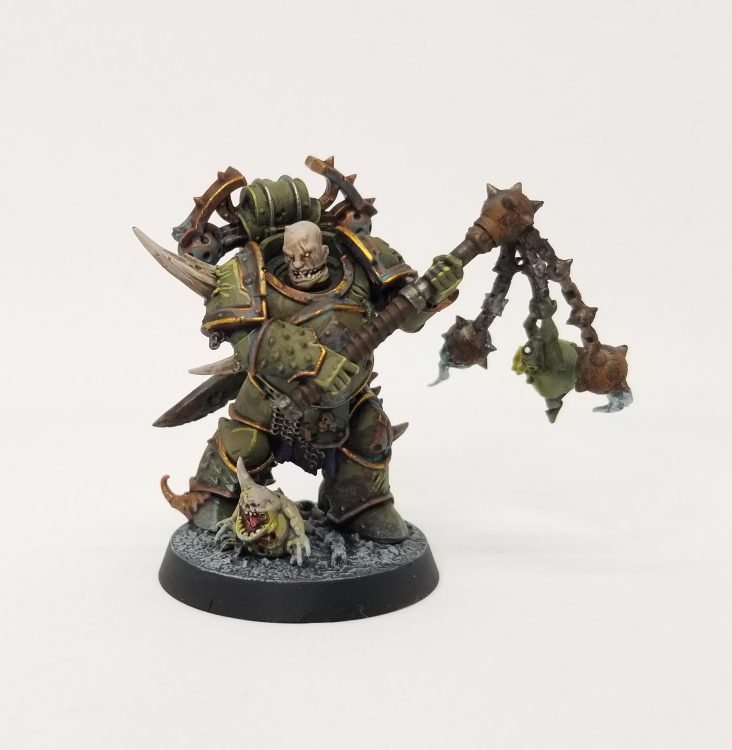
Plague Marine (Fighter)
As discussed in the main review article, melee combat in Kill Team 2.0 is vicious stuff, but a Plague Marine is one of the only models in the game that can arguably get into a fight and plan to come out relatively unscathed. On top of that, plague marines are also more deadly in melee than most factions’ operatives. A Fighter operative can be given a wide variety of powerful weapons. While each of them have something to offer there’s a good argument that the attack rerolls from the double Plague Knives option are likely your best bet, particularly if you bump their damage to 4/5 with the Mephitic Toxin equipment. The Flail is also a solid option here against horde lists, where its Reap 2 attribute means you can dump out 2 mortal wounds to nearby models every time you score a critical hit. And if you’re just looking to double up on the raw damage output of a power fist, the Great Plague Cleaver essentially gives you that option as a 5/7 damage A5, WS4+ weapon, albeit with Rending instead of Brutal, making it easier to parry but giving it higher raw damage potential.
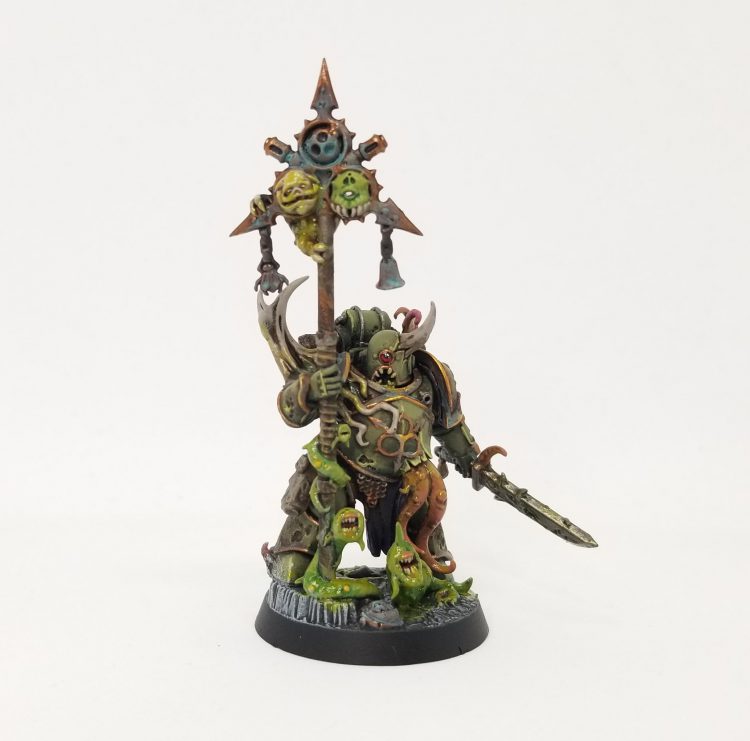
Plague Marine (Icon Bearer)
This is an operative that is such a good force multiplier that they’re almost mandatory in your kill team. The main ability of the Icon Bearer is a unique action called Icon of Decah (1 AP) which, once activated, allows all operatives within ■ to reroll Disgustingly Resilient rolls of 1 or 2. This takes the 33% damage reduction of DR to a staggering 56%, effectively giving an average plague marine around 22 wounds. It cannot be overstated how powerful this can be, as it allows you to soak far more damage and potentially pull some VP from the Damage Limitation Tac Ops. With 3APL, an Icon Bearer can comfortably use the Icon of Decay special action, Move, and Shoot each turn. Alternatively if you want to play it cagey, you can keep the operative concealed to better protect your operative and use the spare AP for Dash or mission-based actions. Because it requires an action, the Icon Bearer will almost always be the first operative you activate on a given turn, unless you have an incredibly pressing need to activate elsewhere first. The big downside is that the icon bearer can make your team predictable – your opponent will know who’s activating first, and will also know that your models need to huddle together for DR re-rolls.

Plague Marine Champion
Your default Leader, the Champion is slightly tougher than your standard Plague Marine (+1W) and has access to a number of special weapons with better stats than other operatives. This model is a strong all-rounder; sticking with a boltgun is probably the best move here (hitting on 2+s and firing twice with Malicious Volleys, of course) and then taking whichever melee weapon you find appealing, though the power fist is probably the best option, as a crit will put in enough damage to knock out lesser operatives in a single go and it can’t be parried with normal successes. Does this ensure you probably take at least a hit in reprisal? Yeah. Does this really matter unless you’re already critically injured? Probably not. The ability to dumpster something immediately on the charge is too good to pass up.
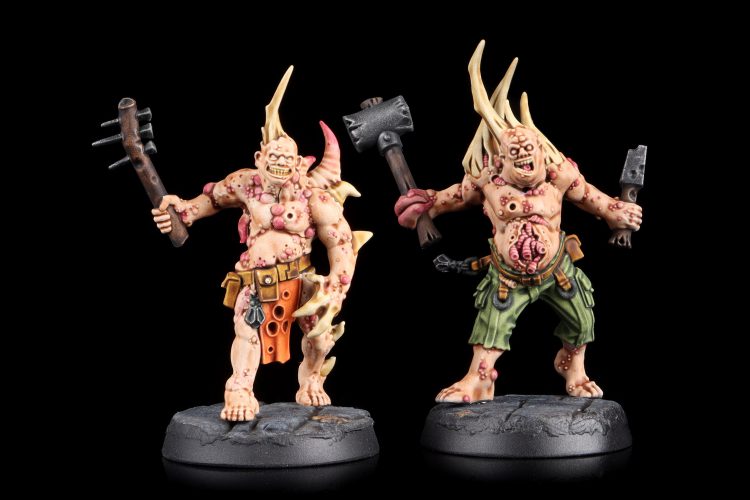
Poxwalkers
A Poxwalker fire team is 8 poxwalkers. If you bring on a Poxwalker “Fire Team”, you’re making a substantial trade by giving up two plague marines for them. As one might expect from a zombie these are not especially helpful for your overall mission but may be used toward pushing some Tac Ops to score general VPs. This *potentially* might be useful in some circumstances, and it does open up the Infiltration Tac Ops options. There are some major downsides though: Aside from having no ranged attacks, being ineffective in close combat, and being slower/weaker, starting with eleven operatives on the table can potentially open you up to giving out free Overwatch actions during each Turning Point until your roster gets whittled down, though most of the time this won’t be an issue since Poxwalkers have a Group Activation (GA) of 2, meaning that even with a full team of 3 plague marines and 8 poxwalkers, you only have 7 total activations. The real utility here is just having more bodies to spread out, but early on Poxwalkers are going ot spend your first turning point or two running at objectives, since they’ll need to be on them at the start of their activation if they hope to perform any actions.
On the whole, Poxwalker Death Guard teams feel less effective than pure plague marine teams, if only because plague marines are so very, very good. You can cover more ground with them but if you’re on a mission like Master the Terminals where there are no objectives in your drop zone and the ones you need to reach require an action, they’re not going to be much help. Where you’re likely to get the most use out of them is on a mission like Seize Ground or Escalating Hostilities, which rewards you for just being on the objective, and where having more bodies and higher total APL for control. That said, because you have 20 slots to fill on your Kill Team roster, 8 of them will always be poxwalkers.
Strategic Ploys
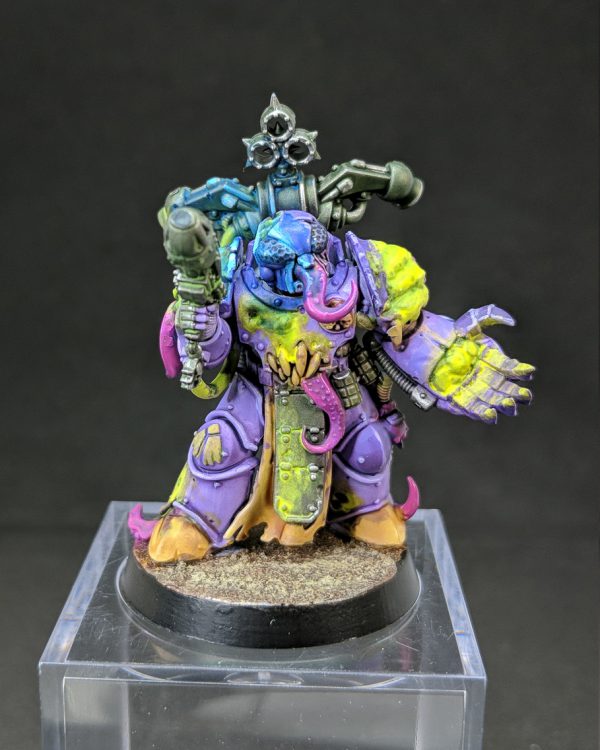
Malicious Volleys (1 CP) – Until the end of the turn, your Plague Marine operatives can take two Shoot actions if they use a bolt weapon for both and do not make a Fight action during the activation. If you’re using or facing Death Guard, this is a ploy you’re going to see hitting the table just about every Strategy phase. Allowing operatives to make a Shoot action twice with a bolt weapon is just grossly powerful in the hands of a faction that can further boost the weapons damage profile to 3/5D. In a world where there’s a good likelihood of being outnumbered, this is a great equalizer (in addition to Overwatch).
Hateful Assault (1 CP) – Until the end of the turn, your Plague Marine operatives who don’t shoot can fight twice during an activation. This is Malicious Volleys’ less useful and more situational cousin. It can be very powerful, but considering how bloody a single round of combat can be, it’s going to be much more rare where this one will come into play. That said, keep it in mind because there’s always a possibility. The best opportunity to use this is to finish off someone who charged you, then charge another target and fight again. This is also going to do the most work on a Fighter with a flail, where maxing out your chances to drop mortal wounds on a bunch of nearby models can be really deadly, but again, that’s not going to be a common occurrence.
Contagion (1 CP) – Until the end of the turn, while an enemy operative is visible and within ⬤ of one of your Death Guard operatives it’s treated as being injured. If your opponent is forcing close-quarters combat, this is a strong ploy to play. This makes your operatives more survivable and can potentially hinder movement if they’re looking to escape the area, making it harder for them to run away from your Fighter operatives. If you’re fielding Poxwalkers, this is decent for swarming their models and reducing their effectiveness, tying them down while your Plague Marines go achieve whatever real goal Nurgle has in mind.
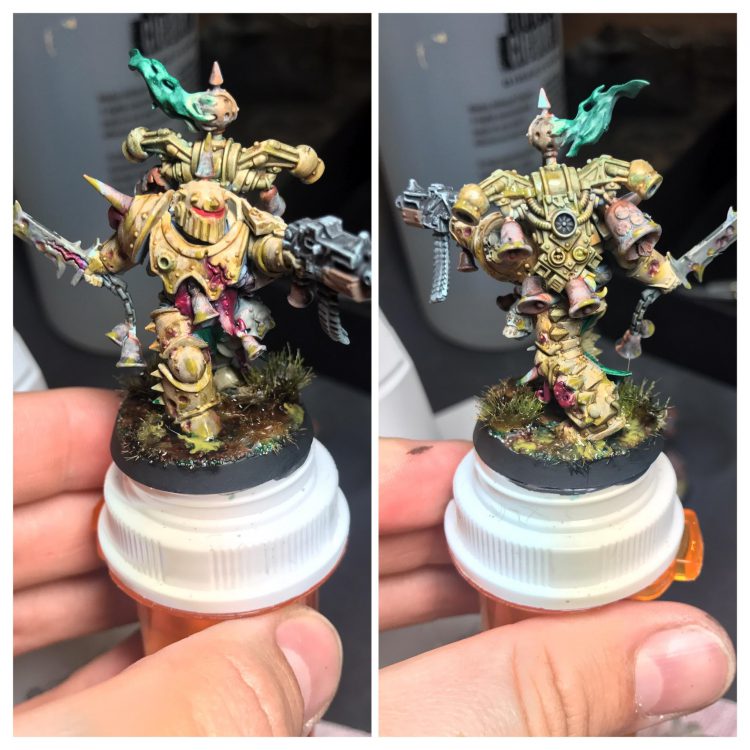
Tactical Ploys
Effluent Demise (1 CP) – Used when one of your plague marines goes down. Do D3 mortal wounds on each enemy operative visible to and within ⬤ of the killed model. Causes minor splash damage when a Plague Marine dies. It’s got a short range and it isn’t a lot of damage, so you’re only really going to use this either when it will kill the model attacking you, or when you’re up against a particularly hard-to-wound target like a Custodian.
Revolting Durability (1 CP) – Used after the resolve hits/resolves saves steps of a combat or shooting attack against one of your Plague marines. You can downgrade a critical hit to a regular hit. This is another highly situational ploy, only viable in a clutch situation where your opponent scores a crit and you absolutely need your operative to live (and remember, you’re doing this before you roll your disgustingly resilient rolls). This is a good way to dodge mortal wounds that you can’t save against if someone’s trying to blast you with a meltagun.
Dig In (1 CP) – Used when a plague marine is activated to give them the Dig In (1 AP) action, which gives them +1 DF until the end of the turn. So you’re spending a CP AND and AP for +1DF. This is a very pricey ploy, indeed, and AP are particularly precious for Death Guard units. Mostly it’s going to be useful for when you absolutely have to have an operative stay live clutching some mission-critical objective or some such, or when you’re dug in to a spot you like with your Icon Bearer, who is likely to be your highest-value target for this. Most of the time it’s going to be too expensive for regular play, however.
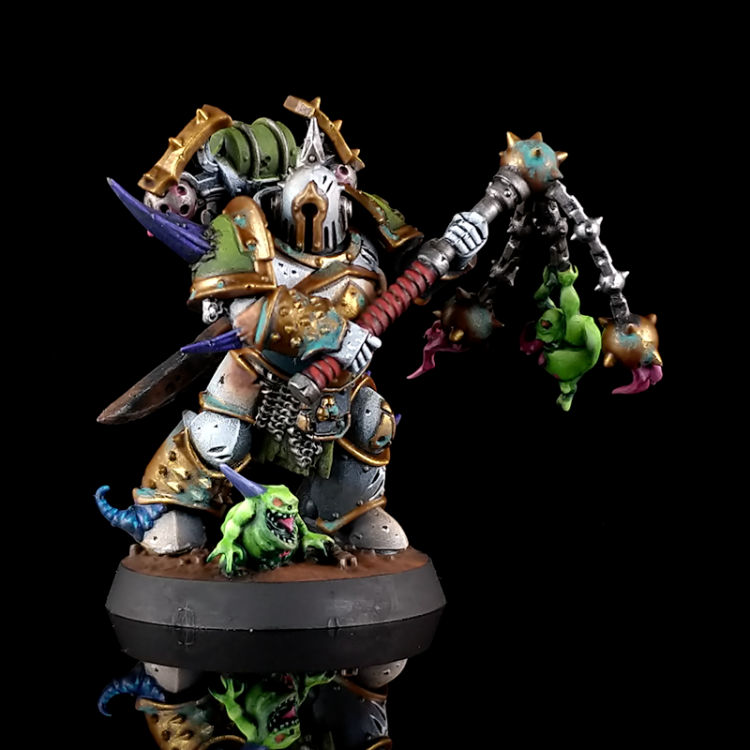
Equipment
Nurgling* (3 EP) – Once per game, if the operative with this is within ■ of an enemy operative they can unleash the Nurgling, sending it scurrying off to commit gross and aggravating antics that give your enemy -1 APL. It’s worth noting that this effect only lasts a turn , and while it could potentially have complicate things for the victim, it’s unlikely to be worth 3 EP. It’s definitely a hilarious option to have in your back-pocket if the enemy leader closes in, but it’s too costly to see often.
Plague Bell* (3 EP) – Gives you the Plague Bell (1 AP) unique action, which adds ⬤ to the Movement characteristic of friendly plague marines within ⬟. This is an excellent force multiplier, especially if your Plague Marine pals are clustering up for bask in the Icon Bearer’s glow. Another big-ticket item, but increasing your base movement by 150% is a pretty big deal. If you plan on grouping your operatives or if you’re on a map requiring quick early-game movement to reach objectives, put this in your EP budget. You won’t need to activate it every turn, but once or twice in the early going should be enough. You probably won’t want it on your Icon bearer, though.
Blight Grenade (2 EP) – Gives you a blight grenade, which is A4, BS3+, 2/3 damage with Range ⬟, Blast ⬤, plus the Indirect, Ceaseless, and Limited rules. A “cheap” grenade option. It could potentially inflict some decent damage on softer targets if you manage to get them clustered up. Bear in mind that each player reveals their roster before you each buy equipment, so if you see you’re facing 10+ enemy operatives definitely think about some blast options. With the ability to ignore Cover, it’s also a good way to flush out operatives trying to hide from you.
Krak Grenade (3 EP) – The “less cheap” grenade option, with 4/5 damage, AP1, and . Much higher damage potential with AP to boot; the consideration mentioned in the Blight Grenade segment above still applies, though this will be better against heavier targets.
Filth Censer (3 EP) – This extends the Contagion range for an operative by ⬤ when you use the Contagion Strategic Ploy. While there may be a point in some matchups where this can be critical, 3EP and a CP for a single operative seems steep. Once you point out the equipment there’s a good chance a smart player will just avoid them or kill them outright if they can.
Virulent Rounds (1 EP) – Gives you +1 crit damage on a bolter or bolt pistol. Pretty much a gimme for any operative that is wielding a boltgun. Potential damage increases on ranged weapons are always a good thing, especially if it’s the default weapon choice. At 1 EP, this will also be how you fill out any extra EP slots you have.
Mephitic Toxin (2 EP) – Improves the plague knife/plague knives normal damage on your operative by 1. While you may not want to consider many Fighters for your roster, if you’re planning on using Plague Knives this is an absolute must. Otherwise, it’s a handy tool for making your regular operatives particularly nasty in melee, since having damage 4/5 attacks base puts them on equal footing with any operative wielding a chainsword.
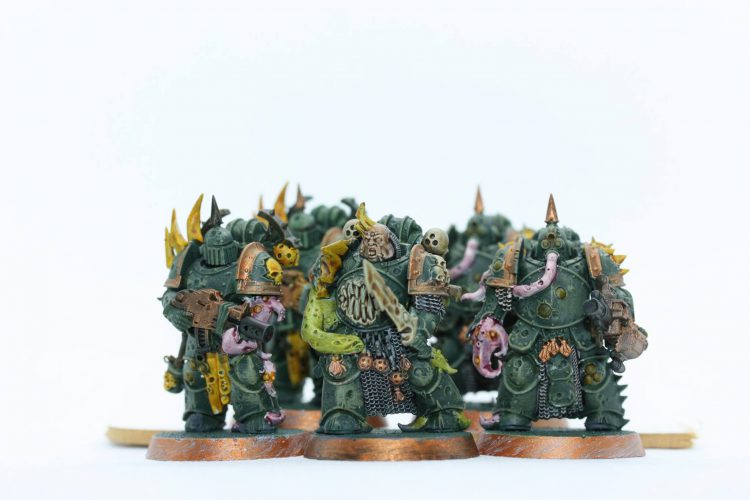
Building a Kill Team
Although there are only two options for fire teams, there’s a good amount of variety to be had with Death Guard and thanks to their resilience most choices are going to be solid on the table. Below are a few examples (including equipment choices) to give you an idea of what works well.
The Roster
You want your roster to maximize your options, and that means you’re going to flesh out as many as possible. You can theoretically swap out a Fighter here for an alternate weapon option – the only operative missing here is one with a mace and axe – but this covers pretty much all of your bases otherwise.
Plague Marine Champion – Power Fist, boltgun
Plague Marine (Icon Bearer) – Boltgun, Plague knife
Plague Marine (Warrior) – Boltgun, plague knife
Plague Marine (Warrior) – Boltgun, plague knife
Plague Marine (Fighter) – Bolt pistol, Plague knives
Plague Marine (Fighter) – Bolt pistol, Great plague cleaver
Plague Marine (Fighter) – Bolt pistol, Flail of Corruption
Plague Marine (Gunner) – Plasma gun, plague knife
Plague Marine (Gunner) – Meltagun, plague knife
Plague Marine (Gunner) – Plague belcher, plague knife
Plague Marine (Heavy Gunner) – Blight launcher, plague knife
Plague Marine (Heavy Gunner) – Plague Spewer, plague knife
Poxwalker
Poxwalker
Poxwalker
Poxwalker
Poxwalker
Poxwalker
Poxwalker
Poxwalker
A Sample Team: Overwhelming Generosity (of Virulent Rounds)
Plague Marine Fire Team (+2CP)
Plague Marine Champion (Boltgun, Powerfist, Virulent Rounds)
Plague Marine Icon Bearer (Virulent Rounds)
Plague Marine Fighter (Blight Grenade, Plague Knives, Mephitic Toxin)
Plague Marine Fire Team
Plague Marine Warrior (Blight Grenade, Virulent Rounds)
Plague Marine Warrior (Virulent Rounds)
This team makes use of the strong combination mentioned in the article earlier, equipping most operatives with bolt weapons, Virulent Rounds, and then double-firing when possible using Malicious Volleys to put out an oppressive amount of firepower. While the idea is to keep most members relatively close to the Icon Bearer, there’s enough flexibility to have some independent operatives achieve separate objectives. To keep a bit of balance and as a potential counter-charge, a Fighter has been included with upgraded plague knives to make use of Relentless re-rolls.
Choosing Your TacOps
Death Guard teams get access to Seek and Destroy and Security TacOps through plague marine fire teams and access to Security and Infiltration through Poxwalkers. Although it’s an option, Infiltration for Poxwalker teams is a tall order – there are three actions in the Infiltrate TacOp set (Upload Viral Code, Sabotage, and Interope), and two of them can’t even be done by Poxwalkers, while the third requires being next to an enemy’s killzone edge, which isn’t likely to happen. Stick with Seek and Destroy and Security. For Seek and Destroy, Execution is among your strongest picks, since you’ll almost always be killing more operatives than you lose, and Deadly Marksman is great on a blight launcher or plasma gun. Challenge is probably a dead pick however, since it’s too easy for an opponent to just spend all game dodging your operative. Your choice picks here are Execution, Deadly Marksman, Rob and Ransack, and Headhunter, in that order. Security TacOps on the other hand are going to reward you for protecting your killzone, and so make for good picks against kill teams that aren’t filled with fast hordes or with wide drop zones. They’re also ideal for plague belcher/spewer gunners who can wreck anyone who comes close.
Final Thoughts
Despite their limited speed, Death Guard kill teams provide a strong core of capable all-rounders that can take on any opponent while still threatening board control with poxwalkers on missions that just require a ton of bodies. In our early games they’ve been an absolute force, and their durability can be an absolute nightmare for mid-range/semi-elite teams that continually see shots bounce off of them.
Have any questions or feedback? Drop us a line in the comments below or shoot us an email at contact@goonhammer.com.
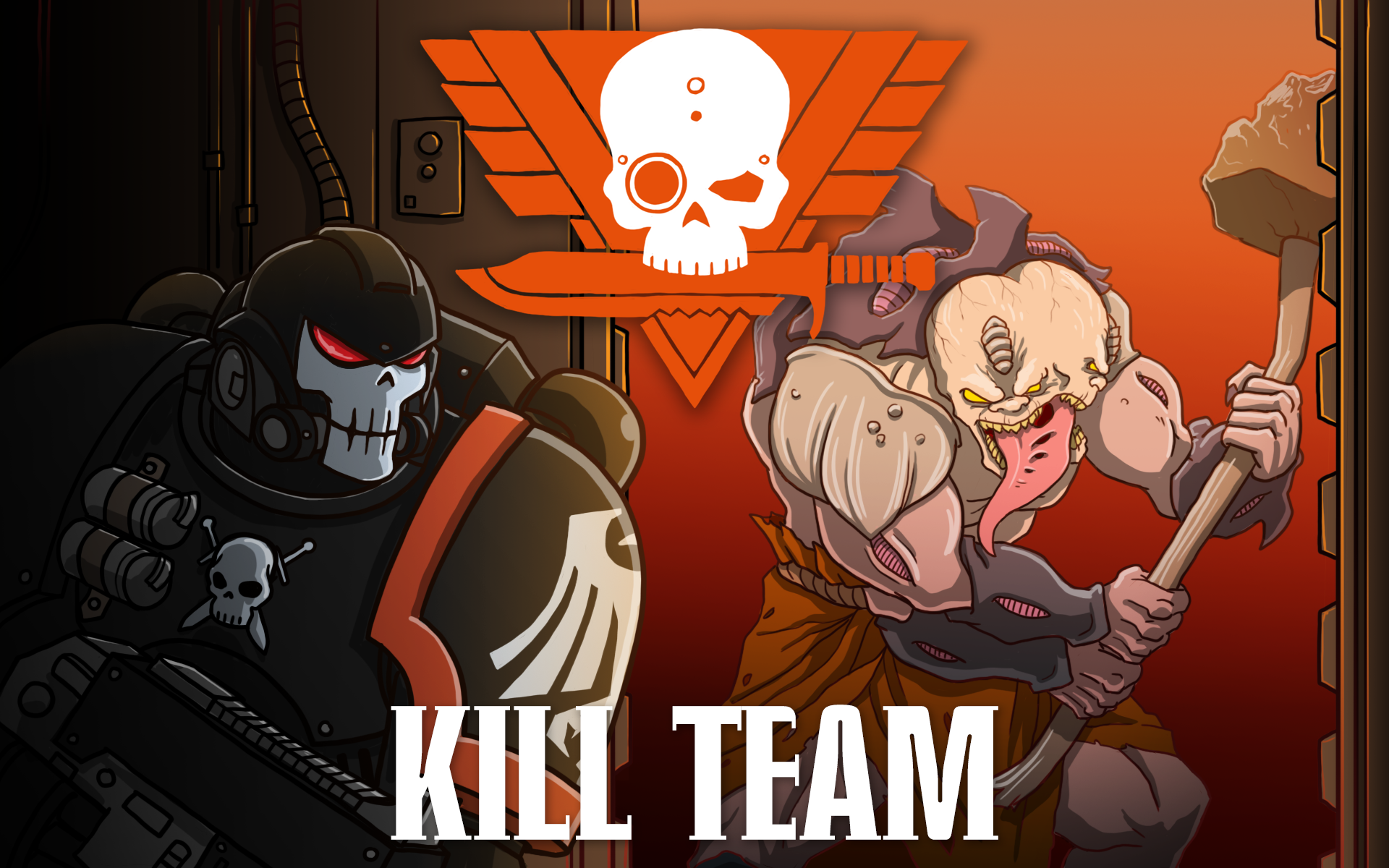


You must be logged in to post a comment.